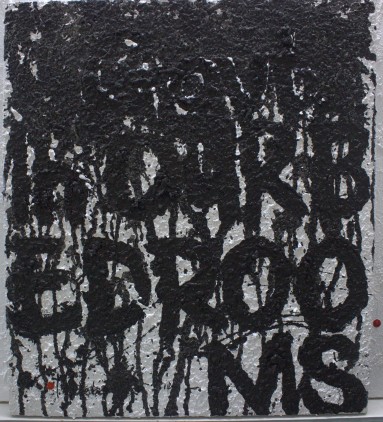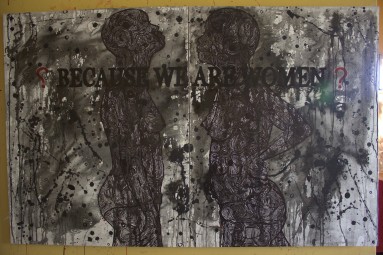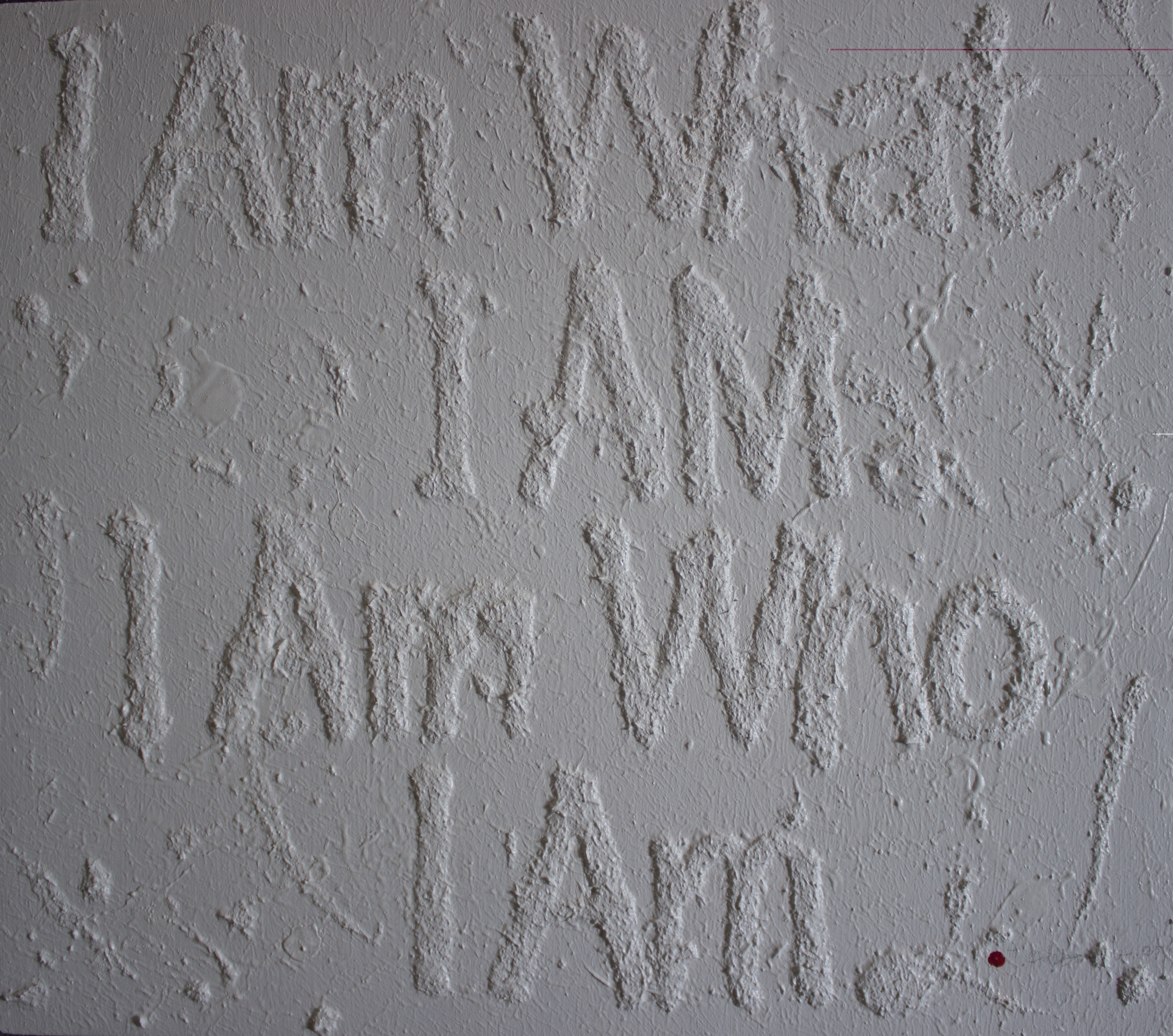A trail of small red dots connect Tyna Adebowale’s body of work.
In the exhibition space where I encountered it, the red dot stood out most vividly against the stark white of “I Am What I Am / I Am Who I Am,” raised white letters against a white background. Visible, at first, as texture—the words become clear as one approaches the work. Seen from a distance, the work is a brilliant white background marked by a red dot—the text is illegible. As one draws nearer and reads the text, one notices the red dot that lies to the left of the complete text. The red dot breaks up the visual field of white against white and hints at what lies outside this declaration: the blood-producing violence that haunts this sotto voce declaration. Also, perhaps, the blood-producing violence against which this declaration stands. Contained within the painting’s frame but located outside the frame of the text, the red dot renders the text talismanic, as though it has the force to push away and contain blood-producing violence.
This red dot can be read otherwise. Before I’d seen more of Tyna’s work, and examined the painting closely, I had assumed it was a small “sold” sticker. I wondered about the economies of circulation and distribution that make “I Am” legible. One cannot help hearing Lady Gaga’s “Born this Way” in the assertive declarations. And, those located in the broad Judeo-Christian tradition cannot help seeing “I AM THAT I AM,” that absolute declaration of transcendent being. “What” and “Who”: materiality and self, body and soul, flesh and spirit, immanence and transcendence. One also hears multiple histories of self-assertion: claims to humanity staged by the not fully human and the unhuman that unsettle the human-restricting figure Sylvia Wynter terms Man.
Here’s Wynter:
The argument proposes that the struggle of our new millennium will be one between the ongoing imperative of securing the well-being of our present ethnoclass (i.e., Western bourgeois) conception of the human, Man, which overrepresents itself as if it were the human itself, and that of securing the well-being, and therefore the full cognitive and behavioral autonomy of the human species itself/ourselves.
Thinking with Wynter and Tyna, we might ask what forms of representational rupture can contest the overrepresentation of Man. What practices of representation? What modes of interpretation? What habits of scrutiny? What assertions can be made:seen:heard against the blinding overrepresentation of whiteness? That I hear these assertions of “What” and “Who” as particular responses within the frames created by Man (in Wynter’s sense) certainly suggests more about my training and inclinations than it does about Tyna’s work. At the same time, it’s difficult, if not impossible, not to hear the “global gay” overrepresented in these assertions—and the “counter-voice” (a term I take from Wynter) struggling to emerge into some kind of legibility. How does the African subject—black, female, queer—emerge from:within the overrepresented white queer subject? What kind of legibility is possible if, following C.L.R. James, one is obliged to use what Audre Lorde terms “the master’s tools”?
*
A friend introduced me to Glenn Ligon’s experiments with texts, his conversations with Baldwin and Pryor, among others. The Ligon piece I encountered in one of the Smithsonian galleries featured an excerpt from James Baldwin. Fortunately, the friend who accompanied me to the exhibition had been reading Baldwin and recognized the text. Black text(ured) against a white background, with the text becoming incomprehensible toward the “bottom” of the canvas. As though an accumulation, a weight of feeling, a force of history rendered completion impossible. Those of us trained to comprehend sentences/statements/representation as it reaches completion—here, the simple idea that one fully comprehends a sentence when one gets to the end of it—are stymied, frustrated by the incomplete fragment, the garbled unending. Minoritization is often this process of incompletion—one’s sentences never end or are heard as never needing to end or are prematurely ended or having ended are never heard as having ended as they should.
Ligon was my entry point to Tyna’s “Govt. In Our Bedrooms.”

Once one knows the title of the work, the letters become legible. At first, one might see
RB
EDROO
MS
cracked language, too massive to fit the canvas. A shouted language, a struggling language. If the densely layered top portion of the canvas represents the privacy of the bedroom, that privacy is already compromised by the “GOVT.” that occupies it, the shadowy government. As we learn more about the scope of global surveillance, as the right to privacy becomes an increasingly impossible fantasy, as various hetero-nationalisms, hetero-capitalisms, and homonationalisms more fully anchor themselves as the “models” of not only “the good life,” but the only possible life, a life guaranteed by increasing modes of surveillance that attempts to get rid of “undesirables” and to monitor “desirables,” we might ask, with Tyna, what it means to recognize the already ubiquitous “GOVT.” is “INOURBEDROOMS.”
Too, we might ask about this “OUR,” this emergent, barely visible “OUR” that takes shape through its consciousness that the “GOVT.” [is] “INOURBEDROOMS.” Recent histories of responses to such surveillance include, “well, if you’re doing nothing wrong” and “get the govt. out of our bedrooms” and “that’s just the way it is”: resignation, irritation, anger, apathy. To this, we might add those of us who stream our lives, inviting any and all eyes into our bedrooms. If your computer has a camera, as mine does, it’s entirely possible that as you write in your bedroom, as I am now doing, you are being watched.
This awareness of surveillance transforms the two red dots in this work into indicators of surveillance: the red dots suggest one is being watched. Being watched might be too benign a description for this surveillance. The red dots also suggest guides from advanced weapons—the laser-like lights we see on tv weapons—transforming “being watched” into being targeted. If that is so, the “OUR” becomes those targeted for surveillance, those whose bedroom lives expose them to risk. Here, “target of surveillance” is also the target of violence—the two red dots also suggest blood.
*
Although Tyna uses text in her other work, “I Am” and “GOVT.” foreground text, or, borrowing from W.J.T. Mitchell, image-text, as a contested field of legibility: “I Am” struggles to be—and to be seen as being—just as “GOVT.” hides in the shadows, regulating, or attempting to regulate, the possible emergence of “I Am.” Two aspects of illegibility are at stake here: “I Am” is an illegibility grounded in fugitivity, those practices of world re-imagining marronage, the hiding in plain sight that re-shapes our visioning possibilities. To see “I Am” as an act of labor, as a making of possibility, is to be drawn into a collective that tries to think of how such an assertion might exist in a world that does not know it can exist. To adapt Wynter’s terms, the human in a Man-pressed world. In contrast, the shadowy “GOVT.” menaces possibility, both through obvious forms of repression, but also through threat and innuendo, whisper and stare, policy and gossip. It unmakes—or attempts to unmake—the possibilities of desire and intimacy, pleasure and experimentation.
*
In “?Because We|Are Women?”—I struggled for hours and days to find a method that would permit me to insert a so-called irony mark—the figures of assertion and surveillance—“I Am” and “OUR”—assume a differently figured status as “Women.” Formal work is needed to engage this enfleshment.

Two sutured canvases create the “frame” and “condition” for the work: split almost exactly in the middle, they create a fracture-mirror, a space of impossible translation, what Janet Halley might term a s/place of “split allegiances.”
Most vividly, the red dot on both sides of the fracture-mirror, of the “divide,” is located in a different relationship to the body.
Were we to follow the history of misogyny in philosophy and culture, it is precisely the period that slices through the figure to produce a question: a question of being, a question of equality. It is precisely the surveillance around the period that, within patriarchal systems, produces “she” as the question. (How old is she? Can she bear children? Should she undergo initiation? Is she adult enough to be married off? Is she too old to be sexualized? Is she clean? Is she dirty? Will she contaminate? Will she produce life?) “She” becomes the canceling question, the “Are Women?” And if we—anglophone readers—insist on reading from left to right, in what Luce Irigaray terms the “same way,” we can only end at “she” as question and questionable.
I linger at the notion of an “improper” mirror, a mirror-fracture, to suggest the possibilities of staying in the gap of what Tavia Nyong’o theorizes as fabulation: the space between representation (as aesthetic practice) and representation (as political praxis).
The mirror-fracture transforms the question mark on the right into an irony mark on the left: a little-used, little-known, barely-acknowledged punctuation mark. A form of tone-knowledge—tone color, my earlier music training insists—irony marks the question on “the right,” the “rightness” of the question, as invasive: created through an invasive-erasing line. It is not simply that the question becomes ironic as it moves from left to right—such a reading would follow reading protocols, ceding the “right” of the “right,” the “right” of “rightness.” (Heteronormativity, Lauren Berlant and Michael Warner remind me, is a “sense of rightness.”) Instead, it might be that irony is transformed in the mirror-fracture. Tavia’s notion of fabulation would ask us to linger on the “possibilities” created in/at/by the fracture, to stay with seam-work:seem-work:seeming-work.
Desire enters at and as this mirror fracture: recall, I first saw this image during a queer-themed exhibition. Tyna’s stylized “Women?” incline toward each other—with the figure on the right insisting on the “rightness” of her desire: her arms support and push her toward the left, her stance moves toward the left. “She” is more forward, even positioned slightly closer to the “mirror-fracture.” She “pulls” toward the “Because We” inhabited by the figure on the “left.” I’m trying not to make too much of a politics framed as “left/right,” because I’m not sure how well it translates across geo-histories. And I’m also trying not to re/produce what Irigaray might term the logic of the same by working with an active/passive dynamic. Instead, I am interested in the metaphor:labor of the “pull,” the interpellation of that “We” as it calls across the mirror-fracture, interested, that is, in the call of the “We,” in its capacities to fabulate.
Because my mind is a little too attuned to angles—trained to see them even as I have never been able to comprehend trigonometry and geometry—I wonder about the meeting place of the irony mark and the question mark as they move into the periods and out of the frame. I wonder about the “V” shape they produce, about its enframing logics and its trajectory as it meets across the mirror-fracture—if, in fact, it meets across the fabulating mirror-fracture.
But to think with pattern—with shapes and angles—requires engaging with the patterns that compose the women figures. As Tyna tells me, these are “non-traditional”: “They evolved from my other paperworks and found their way onto my canvas surface.” These are “fabulations,” forms of “radical waywardness,” to cite Hortense Spillers, which “pattern” and “body” these women figures in ways that demand we learn to look and see differently. (I hope that someone with a richer art vocabulary than I can imagine will engage this pattern-work, this rich movement in and across figuration and being.)
I’m never quite sure how to conclude speculative work—attempts to engage with creation and fabulation, encounter and undoing. I tend to slip away from gallery spaces and performances, to try to populate what Ladan Osman taught me to call a “memory museum” with material that will be “useful.” During the Critically Queer exhibition, my gaze kept returning to Tyna’s work, trying to figure out what it was seeing, what it was missing, what it was fabulating, how it was being fabulated. I’m grateful that Tyna allowed me to think with her work. I hope I’ve been able to capture some of the magic I’ve encountered in it.
